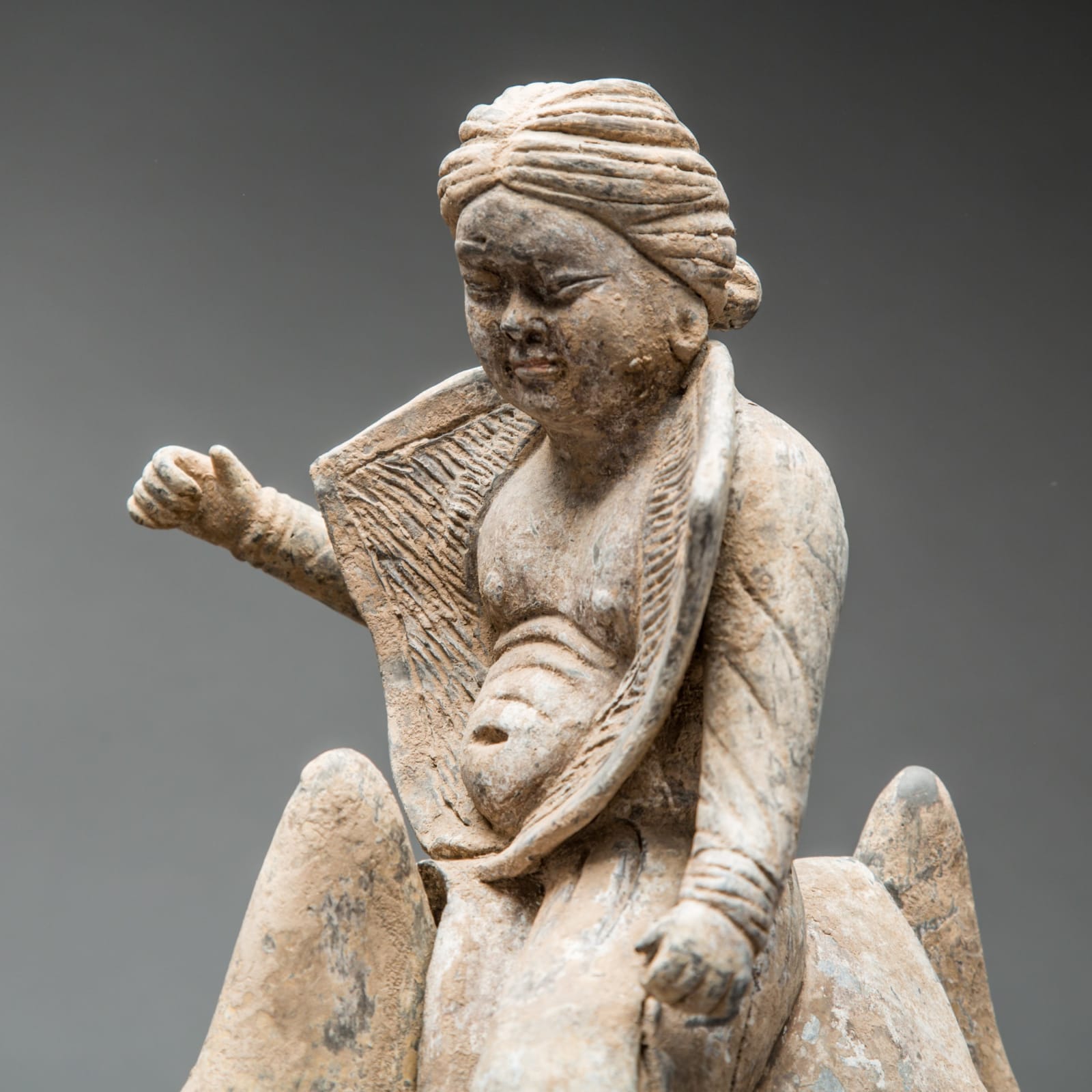Tang Terracotta Camel and Removable Rider, 7th Century CE - 8th Century CE
Terracotta
61 x 48.3 cm
24 x 19 in
24 x 19 in
H.1087a
Further images
This sculpture of a camel and rider is a gorgeous example of the refined artistry of works mingqi art from the Tang Dynasty. The distinct physiognomy of the removable rider,...
This sculpture of a camel and rider is a gorgeous example of the refined artistry of works mingqi art from the Tang Dynasty. The distinct physiognomy of the removable rider, featuring deep-set squinting eyes and fleshy cheeks, reveals that he is of foreign descent, most likely from Central Asia. His hair has been tied back in a ponytail. Incised lines along the top of his head indicate individual locks of hair. He wears a jacket with a broad lapel and his right arm is raised. This may once have held a whip or similar item fashioned from a perishable material that no longer survives. This attire and posture is consistent with other representations of foreign riders. A flask with a red heart-shaped decoration hangs on each side of his saddle. Thick tufts of furry hair cover the camel along his head, neck, and front knees. The camel holds his mouth wide open, exposing his teeth.
This sculpture reveals the Tang Dynasty’s respect and admiration for this beast of burden, so essential to the prosperity of ancient China. This remarkable beast was able to withstand the scorching heat of the desert, the cold of the mountains and still maintain its own nutrients, surviving for months without fresh supplies of water. “The camel is an unusual domestic animal; it carries a saddle of flesh on its back; swiftly it dashes over the shifting sands; it manifests its merit in dangerous places; it has a secret understanding of springs and sources, subtle indeed is its knowledge.” This quote, by Guo Pu, dates from the 3rd Century A.D. and shows the extent to which the Chinese praised camels. For the Chinese, these creatures symbolized the wealth and luxury and Tang artists began to create charming representations of these prized creatures as mingqi in order to symbolize continued wealth and prosperity throughout the afterlife. The Tang Dynasty was an era of unrivalled wealth and luxury. The arts reached new levels of sophistication. Poetry and literature flourished under the enlightened rulers. Tang China was a multicultural empire where foreign merchants from across Central Foreign traders lived next to native artisans and both thrived. New ideas and exotic artistic forms followed alongside. In essence the Tang Dynasty was a cultural renaissance of sorts, where many of the forms and objects we now associate with China were first created. Moreover, this period represents one of the greatest cultural outpourings in human history. - (H.1087a)
This sculpture reveals the Tang Dynasty’s respect and admiration for this beast of burden, so essential to the prosperity of ancient China. This remarkable beast was able to withstand the scorching heat of the desert, the cold of the mountains and still maintain its own nutrients, surviving for months without fresh supplies of water. “The camel is an unusual domestic animal; it carries a saddle of flesh on its back; swiftly it dashes over the shifting sands; it manifests its merit in dangerous places; it has a secret understanding of springs and sources, subtle indeed is its knowledge.” This quote, by Guo Pu, dates from the 3rd Century A.D. and shows the extent to which the Chinese praised camels. For the Chinese, these creatures symbolized the wealth and luxury and Tang artists began to create charming representations of these prized creatures as mingqi in order to symbolize continued wealth and prosperity throughout the afterlife. The Tang Dynasty was an era of unrivalled wealth and luxury. The arts reached new levels of sophistication. Poetry and literature flourished under the enlightened rulers. Tang China was a multicultural empire where foreign merchants from across Central Foreign traders lived next to native artisans and both thrived. New ideas and exotic artistic forms followed alongside. In essence the Tang Dynasty was a cultural renaissance of sorts, where many of the forms and objects we now associate with China were first created. Moreover, this period represents one of the greatest cultural outpourings in human history. - (H.1087a)











